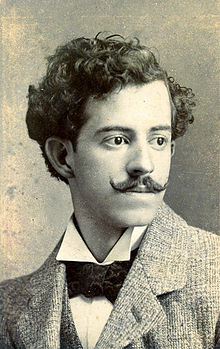Guillermo Valencia
Guillermo Valencia | |
|---|---|
 | |
| Born | Guillermo Valencia Castillo October 29, 1873 |
| Died | July 8, 1943 (aged 69) Popayán, Colombia |
| Occupation(s) | Poet, translator |
| Spouse | Josefina Muñoz de Valencia |
| Children | Guillermo León Valencia Josefina Valencia Muñoz |
| Parent(s) | Joaquín Valencia Quijano Adelaida Castillo Silva |
Guillermo Valencia Castillo (October 29, 1873, Popayán, Colombia – July 8, 1943, Popayán) was a Colombian poet and translator. He was the father of Guillermo León Valencia (1909-1971), Colombian president during 1962-1966.
His first volume of poetry, Ritos (1898, rev. ed. 1914; “Rites”), containing original poems and free translations from French, Italian, and Portuguese, established his literary reputation at home and abroad as a leader of the experimental Modernist movement with its exotic imagery. Unlike many of the Modernists, however, he was an escapist only in his poetry, not in his own life. He led an active career as a statesman and a diplomat and was twice a candidate for the presidency of Colombia, in 1918 and 1930.[citation needed]
He had the poetry Magazine Paginas de Anarkos, this treasure of poetry was the journal for the most prestigious Poets and artists of the time. It had illustrations by masters like Santiago Martinez Delgado.[citation needed]
He was never a prolific poet; in later years, he abandoned original poetry almost entirely, concentrating on translations. One of these was Catay (1928; “Cathay”), which he translated from Franz Toussaint's La Flute de Jade (“The Jade Flute”), a French translation of an anthology of Chinese poems. He translated La balada de la cárcel de Reading (1932; “The Ballad of Reading Gaol”) from the English poem by the 19th-century writer Oscar Wilde. He also turned more frequently to writing essays, many of which are collected in Panegíricos, discursos y artículos (1933; “Panegyrics, Speeches, and Articles”).[citation needed]
